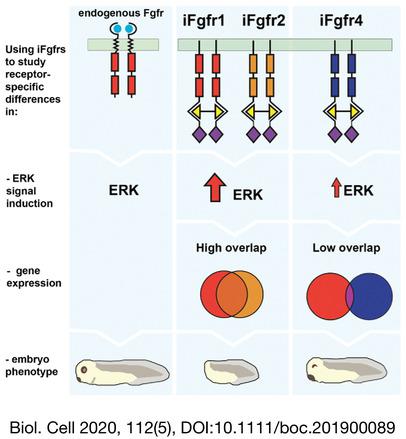当前位置:
X-MOL 学术
›
Biol. Cell
›
论文详情
Our official English website, www.x-mol.net, welcomes your
feedback! (Note: you will need to create a separate account there.)
A comparative analysis of fibroblast growth factor receptor signalling during Xenopus development
Biology of the Cell ( IF 2.4 ) Pub Date : 2020-02-17 , DOI: 10.1111/boc.201900089 Hannah Brunsdon 1 , Harry V Isaacs 1
Biology of the Cell ( IF 2.4 ) Pub Date : 2020-02-17 , DOI: 10.1111/boc.201900089 Hannah Brunsdon 1 , Harry V Isaacs 1
Affiliation

|
The fibroblast growth factor (FGF) signalling system of vertebrates is complex. In common with other vertebrates, secreted FGF ligands of the amphibian Xenopus signal through a family of four FGF receptor tyrosine kinases (fgfr1, 2, 3 and 4). A wealth of previous studies has demonstrated important roles for FGF signalling in regulating gene expression during cell lineage specification in amphibian development. In particular, FGFs have well‐established roles in regulating mesoderm formation, neural induction and patterning of the anteroposterior axis. However, relatively little is known regarding the role of individual FGFRs in regulating FGF‐dependent processes in amphibian development. In this study we make use of synthetic drug inducible versions of Xenopus Fgfr1, 2 and 4 (iFgfr1, 2 and 4) to undertake a comparative analysis of their activities in the tissues of the developing embryo.
中文翻译:

非洲爪蟾发育过程中成纤维细胞生长因子受体信号的比较分析
脊椎动物的成纤维细胞生长因子 (FGF) 信号系统很复杂。与其他脊椎动物一样,两栖类爪蟾的分泌 FGF 配体通过四个 FGF 受体酪氨酸激酶家族(fgfr1、2、3 和 4)发出信号。大量先前的研究已经证明 FGF 信号在两栖动物发育的细胞谱系规范过程中调节基因表达中的重要作用。特别是,FGF 在调节中胚层形成、神经诱导和前后轴模式化方面具有公认的作用。然而,关于个体 FGFR 在调节两栖动物发育中 FGF 依赖过程中的作用,我们知之甚少。在这项研究中,我们利用了非洲爪蟾 Fgfr1、2 和 4(iFgfr1、
更新日期:2020-02-17
中文翻译:

非洲爪蟾发育过程中成纤维细胞生长因子受体信号的比较分析
脊椎动物的成纤维细胞生长因子 (FGF) 信号系统很复杂。与其他脊椎动物一样,两栖类爪蟾的分泌 FGF 配体通过四个 FGF 受体酪氨酸激酶家族(fgfr1、2、3 和 4)发出信号。大量先前的研究已经证明 FGF 信号在两栖动物发育的细胞谱系规范过程中调节基因表达中的重要作用。特别是,FGF 在调节中胚层形成、神经诱导和前后轴模式化方面具有公认的作用。然而,关于个体 FGFR 在调节两栖动物发育中 FGF 依赖过程中的作用,我们知之甚少。在这项研究中,我们利用了非洲爪蟾 Fgfr1、2 和 4(iFgfr1、











































 京公网安备 11010802027423号
京公网安备 11010802027423号